Yoga is another new adjunct treatment approach that has achieved rave reviews for its health benefits. What’s incredible is that yoga for addiction recovery is effective and budget-friendly. In addition to various approaches to treating drug abuse, its incorporation in addiction recovery programs has increased. Medical researchers are now pursuing further studies to clarify if healing addiction with yoga is achievable.
Table Of Contents:
- What Is Yoga and Its Types?
- What Are the Benefits of Yoga Treatments?
- How Is Yoga for Addiction Recovery Useful?
- What Does Science Have to Say About Healing Addiction with Yoga?
- What Are Its Effects on the Brain?
- How Mindfulness-based Relapse Prevention Works?
- How to Incorporate Yoga for Addicts in the Treatment Program?
- What Are The Different Yoga Poses for Addiction Recovery?

What Is Yoga, And What Is The Point Of Practicing It?
Yoga is an ancient Hindu philosophy that focuses on and combines physical, mental, and spiritual aspects. It is achieved through different exercises known as yoga poses (asanas). However, its true nature comprises more than just the physical exertion of the postures and the mental concentration of meditation. Much of the philosophy behind this, which comprises the eight limbs of Ashtanga yoga, espouses concepts like moral principles, striving toward self-awareness, and mental focus. Its concepts most familiar to Western culture are the limbs emphasizing posture (asana) and meditation (dhyana).
Types of Yoga
Different types of yoga for addiction have contributed to its sustained popularity over several years.
Below Are Its Main Types That Are Widely Performed to Help One With Improving the Lifestyle:
- Hatha. It is the most common form that refers to any type of yoga teaching physical postures. The procedure includes meditation and posture exercises to improve sleep, boost mindfulness, and reduce stress.
- Bikram. It consists of 26 physically demanding poses and a sequence of two breathing exercises. It is a form of hot yoga performed in a room heated to 104°F in 40% humidity to enable people to get deeper into postures, improve blood circulation, and help in body detox.
- Bhakti. Bhakti is its spiritual type, centered on loving devotion and includes regular prayer, singing, dancing, and celebrating. Unlike other types, this one doesn’t use any poses during practice. The benefits of this form a practitioner gets include relief from stress and a sense of gratitude.
- Jnana. This type uses meditation to seek intellect and self-realization. The exercise employs philosophical discussion, intellectual debates, and introspection. It aids with anxiety and stress relief and increases concentration power.
- Karma. It is another form of yoga that is performed through selfless action for the welfare of others. It is formed through different body movements that help individuals detach themselves from their actions and control their egos.
Benefits of Yoga Treatments
Today, yoga is not only used to increase muscular activity and improve posture but also as an alternative method for medical treatment. Basically, it is a workout that involves both body and mind and offers numerous health benefits.
Some of Its Major Benefits Are as Follows:
Reduces Anxiety
Many people practice yoga now to cope with feelings of anxiety. Research shows that its practice can help with decreasing stress. As per one study, over half of the participants with PTSD stopped showing symptoms of severe anxiety after performing this exercise for weeks.
Combats Depression
Yoga has become an increasingly popular complementary therapy used to treat depression, stress, and other mood disorders, due to its ability to enhance feelings of relaxation and encourage an optimistic look on life. A study revealed that patients in an alcohol dependence program practiced a specific type of yoga for addiction. After a couple of weeks, they had lesser symptoms of depression and reduced cortisol levels.
Improves Heart Health
Research has shown that yoga can help improve heart health and lower risk factors for heart conditions by minimizing stress. A study found that heart patients, who made lifestyle modifications, such as a year of yoga training combined with stress management and dietary changes, had a 23% decrease in total cholesterol. Plus, the development of heart illness stopped in nearly 47% of patients.

Promotes Healthy Eating Habits
This form of exercise has been found to promote mindful eating habits that help control blood sugar, treat disordered eating behaviors, and increase weight loss. In addition, those who practice yoga were found to have a decrease in eating disorder symptoms and weight gain.
Encourages Natural Healing Process
Yoga practice can be beneficial to build an environment that enables the body’s innate healing powers to kick in. The effects of mindfulness on the immune system enhance the body’s ability to combat illnesses and restore health. With strengthening and lengthening, this exercise increases mobility. Furthermore, its practice can lead to improved sleep patterns and great well-being, improving quality of life.
Yoga For Addiction
A melding of the various physical and mental techniques involved in the different yoga forms has been shown to have the most positive effects, physically, mentally, and emotionally. The belief is that yoga for addiction is also a spiritual pursuit that helps increase its effectiveness in terms of bestowing a more relaxed mental state onto the one practicing it.
Since most meditation practices involve the management of the mind’s energy and impulses, those who perform this exercise and meditation experience greater mood stability in the face of outside pressures. Having a calm mind and being mentally stable can contribute to the avoidance of self-harming behaviors and activities like substance abuse.
Yoga for addiction recovery can be used as a complementary therapy but not a replacement to detox programs or medication-assisted treatment.
Brain scans performed on substance abusers reveal hyperactivity in regions of the brain that signify a greater propensity to be self-interested and vulnerable to mood and behavioral disorders. Meditation and yoga for addicts strive to release from the concept of the self, something that goes back to the core principles of this exercise.
Practicing these exercises displays greater connectivity of all regions of the brain. They can achieve a sort of cerebral balance that the brains of substance abusers do not have since most of their brain activity focuses on satisfying their immediate physical needs (addiction). It offers a unique combination of physical exercise and relaxation techniques, and unlike most other conventional exercise and meditation trends, it connects the body with the mind and soul. It teaches self-control and relaxation that leads to the achievement of ultimate liberation, called “Moksha.”
Though it is relatively new in Western culture, it has already gained much attention and acceptance over the recent years. As a result, western medical researchers have gradually started to acknowledge its benefits in various fields. These include disease prevention, management, and treatment.
What Does Science Have To Say About Healing Addiction with Yoga?
Extremely high numbers represent the benefits of yoga for addiction recovery. What’s more, several scientific studies back that with yoga addiction recovery is possible.
- With mindfulness-based interventions like yoga, addiction recovery, treatment, and prevention are possible. People can use this therapy to break the cycle of negative emotions and addictive behavior by creating a sense of self-control and self-realization.
- Low gamma-aminobutyric (GABA) levels are linked to negative mood disorders like anxiety and depression, which substance abusers commonly experience. Research has shown that yoga boosts GABA levels by 27% and is even more effective in decreasing anxiety than walking.
- This exercise can help people throughout addiction recovery reduce withdrawal symptoms and cravings. A study revealed that yoga for addicts has proven to be effective in decreasing the cravings for tobacco and nicotine.
- Performing this exercise also helps manage chronic pain in individuals who abuse alcohol or opiates. According to a study, yoga has demonstrated impressive success in treating chronic pain since it offers an alternative coping strategy for such people.
Over 80% of people reported reduced stress as a result of practicing yoga. Several studies have revealed that psychotherapy, when combined with yoga, is more beneficial than standard methadone treatment, even for drugs like heroin or other opioids. This exercise lowers the symptoms of anxiety and stress, which eventually cause cravings, followed by relapse.
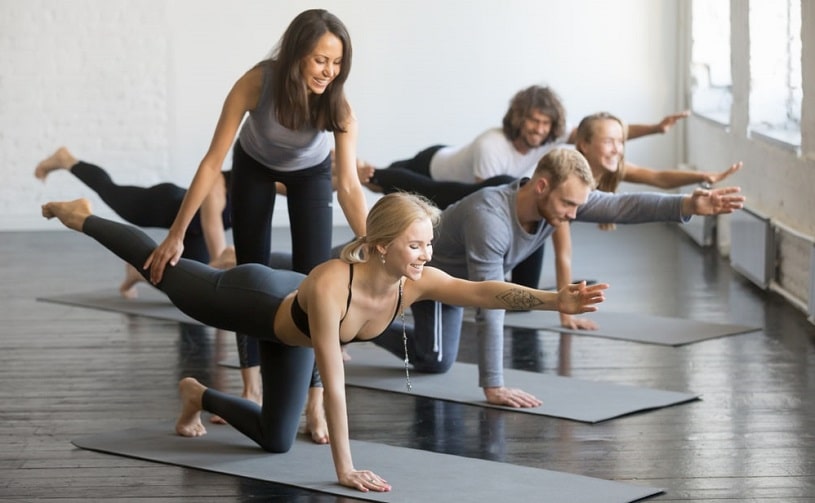
Rhythmic breathing exercises can also help control cravings for nicotine. Many researchers attempt to achieve this result in large populations, and as a result, this form of exercise may become helpful in reducing the incidence of tobacco-related cancers. Furthermore, it can help people undergoing heroin detox by improving their mood and quality of life.
Yoga Effects on the Brain
The combination of asanas, breathing techniques, and meditation produces positive structural and functional changes in the brain, as per the recent research published in the journal Brain Plasticity. Its practice benefits different brain parts, such as the amygdala, prefrontal cortex, hippocampus, cingulate cortex, and brain networks, default mode network (DMN) in particular.
Studies also show that it slows down the age-related and neurodegenerative decline in the brain. Brains of yoga practitioners had more gray matter volume, which is associated with better mental function, and more cortical thickness, which is linked to higher intelligence. Furthermore, the brain releases all types of chemicals while performing this exercise that helps relax and decreases anxiety levels, including GABA, endorphins, and dopamine.
Mindfulness-Based Relapse Prevention
Its integration with meditation into a single program to help prevent relapses among substance abusers was finally achieved by creating the mindfulness-based relapse prevention program. Originally a method taught to chronic pain sufferers, mindfulness-based relapse prevention (MBRP) has recently found traction as an effective technique to help addiction sufferers rewire their brain’s circuitry to avoid relapsing.
The main thrust of MBRP is to help people respond to cravings and stress in a healthy, non-destructive way, which means not resorting to chemicals. MBRP involves group sessions that last for eight weeks. It combines traditional substance abuse treatments like cognitive behavioral therapy with mindfulness elements.
The program was initially known as MBSR (mindfulness-based stress reduction). It was taught to individuals suffering from chronic illnesses to help them face their plights with a greater sense of self-awareness and acceptance. The more relaxed people became about their situation translated to lower incidences of relapse. Asanas formed a part of the initial MBSR program, but the MBRP program utilizes easier poses and movements, given the poor physical condition in which some addicts find themselves.
A trial run on the effectiveness of MBRP found that those who had taken part in MBRP had lowered their chances of relapsing compared to those who did not partake. MBRP leads to a more self-aware state of mind, wherein an individual can understand their responses to external stimuli, rather than simply reacting emotionally, leading to depressive states and eventual self-medicating.
Taken alongside conventional addiction treatments, MBRP can successfully prevent relapses among substance abusers. In a nutshell, yoga for addiction, with meditation and Western psychological therapies, is an effective, low-cost alternative therapy. Additionally, yoga for addicts promises a better and faster recovery from substance abuse. With favorable results from numerous scientific studies, it slowly makes waves in the medical field. As a result, yoga treatments will probably become a definitive tool for individuals recovering from drug abuse and addiction over the next few years.
Incorporate Yoga In Your Treatment Program
Seeing that its practice gives addicts a new, healthier alternative to their old way of life, many addiction treatment facilities offer yoga treatments as a part of their holistic treatment programs. On the other hand, some centers provide this exercise as a complementary group therapy program for different behavioral health concerns.
Experts at the rehab center teach coping skills that they can use. They also get the tools required to avoid relapse. The center designs an individual treatment plan of yoga for addicts, keeping the key areas of concern in focus. The insurance providers cover most of the rehab and associated therapies.
Poses of Yoga For Addiction Recovery
Listed below are the poses that one can adapt as a routine and then build on with more advanced poses as they become more confident. Doing it in the morning is an excellent way to start the day, as the body collects and focuses energy on overcoming daily tasks and eventually getting back to a drug-free life.
A Quick Reminder:
- Wear loose-fitting clothing
- Choose a silent place
- Do not eat a heavy meal before starting any pose
If one doesn’t have an exercising mat, they can use a big towel. Lastly, always do this exercise on a flat and hard surface.
While practicing, simply focus the attention on the breath (inhale and exhale). It might be easier to maintain focus if one is sitting or lying and closing their eyes. Pay attention to inspiring thoughts and the present moment. Notice if the mind wanders and return the focus to the breath as it goes in and out. Take an instant notice of how the body feels at the moment. Notice thoughts and emotions.
Even a 20-minute workout is beneficial to health. Start with simple poses. Once some flexibility and confidence are gained, one can move to more advanced routines that demand more experience.
-
Vajrasana (Thunderbolt Pose)
This pose forms good posture, boosts confidence, and prepares for other, more complicated poses.
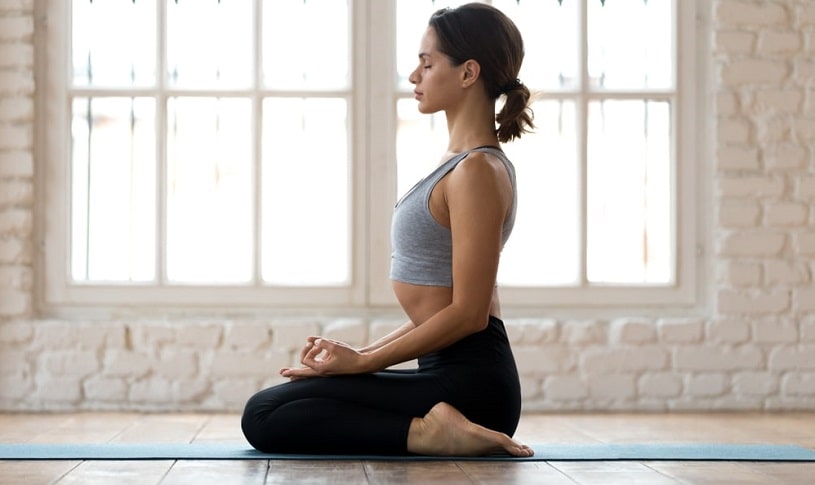
How To Do It?
Start by kneeling on the floor. Knees should point forward. One can put a pillow or folded towel under the buttocks for more comfort. Relax the arms remembering to sit straight and keep the chest open. Focus on breathing and how the air moves in and out of the body. Optional: join the hands together and hold them in front of the chest. Continue this for a few minutes before moving on to the next pose.
2. Balasana (Child’s Pose)
Nothing is more peaceful than returning to that state of childlike innocence. This resting pose stretches the whole body and relieves it of the stress of adult life.
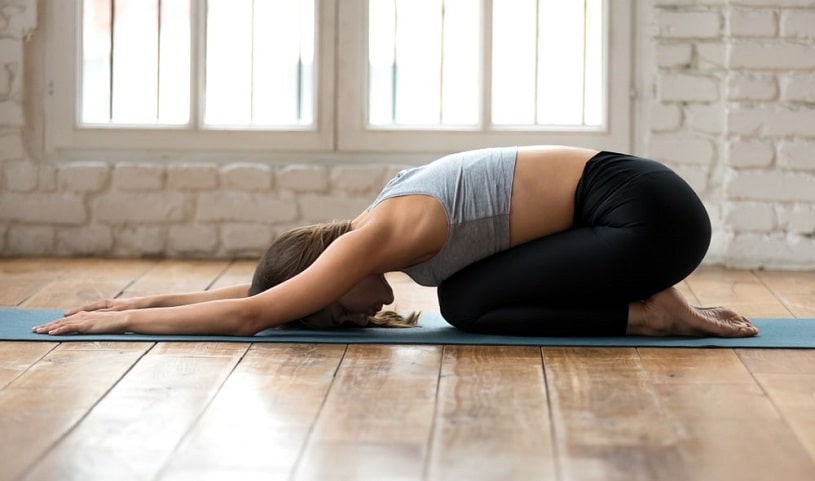
How To Do It?
Kneel down with thighs slightly apart. Raise hands over the head and slowly bring them forward to touch the floor with the palms. Keep both arms stretched out towards the mat and breathe as naturally as possible. Try to relax all the muscles. Stay in this position for a few minutes as the last step.
3. Matsyasana (Fish Pose)
This pose boosts the body’s energy, combats fatigue, and increases spinal flexibility while stretching the body front, upper back muscles, and neck.
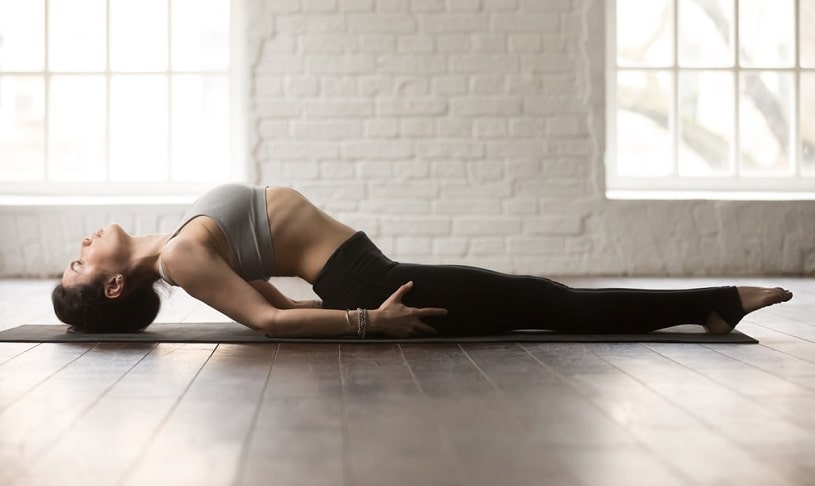
How To Do It?
The first step is to lie down with arms on both sides and palms down. Press elbows and forearms into the floor and raise the chest to arch the back. Next, raise the shoulder blades and upper torso from the floor, move the head back, and bring the head crown to the floor. Press through the heels and hold for five breaths. Now, press through your forearms to slightly lift the head off the floor. Exhale while lowering torso and head to the floor.
4. Adho Mukha Svanasana (Downward-Facing Dog)
One of the common poses, Adho Mukha Svanasana, strengthens the core and improves blood circulation while stretching the body.
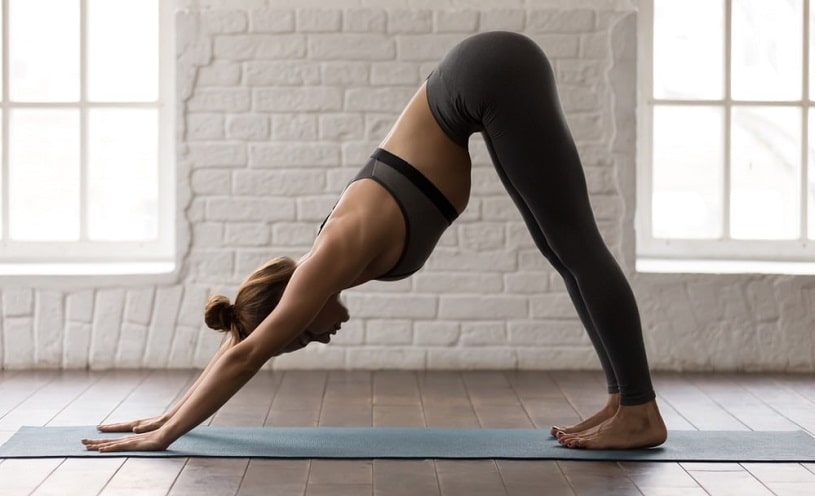
How To Do It?
Come to knees and hands with wrists underneath the shoulders and knees below the hips. Curl toes under and push back through hands. Spread fingers and ground down from the forearms into the fingertips. Turn upper arms outward and let the head hang while moving the shoulder blades away from the ears towards the hips. Move thighs inward, keep the tail high, and drop the heels towards the floor. The last step is to exhale and bend knees to come back on the first position.
5. Savasana (Corpse Pose)
This pose can be done either in between sequences of routine or at the end as a meditation pose. It helps people alleviate stress and symptoms of mild depression and lower blood pressure and fatigue.
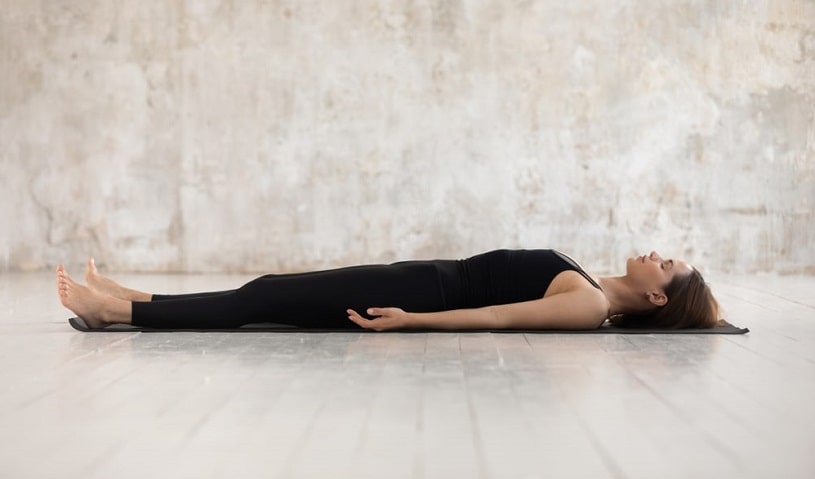
How To Do It?
Lie on the back on a mat and keep the legs slightly apart. The next step is to lay with arms slightly to the side with palms facing upwards. Breathe deeply and concentrate on breathing – breathe in through the nose and out with the mouth.
Note: If one has experienced problems with the back or has other medical issues, it is recommended to consult the doctor before starting any exercises.
Hope Without Commitment
Find the best treatment options. Call our free and confidential helpline
Most private insurances accepted
Page Sources
- van der Kolk, B. A., Stone, L., West, J., Rhodes, A., Emerson, D., Suvak, M., & Spinazzola, J. (2014). Yoga as an adjunctive treatment for posttraumatic stress disorder: a randomized controlled trial. The Journal of clinical psychiatry, 75(6), e559–e565. https://doi.org/10.4088/JCP.13m08561
- Woodyard C. (2011). Exploring the therapeutic effects of yoga and its ability to increase quality of life. International journal of yoga, 4(2), 49–54. https://doi.org/10.4103/0973-6131.85485
- Vedamurthachar, A., Janakiramaiah, N., Hegde, J. M., Shetty, T. K., Subbakrishna, D. K., Sureshbabu, S. V., & Gangadhar, B. N. (2006). Antidepressant efficacy and hormonal effects of Sudarshana Kriya Yoga (SKY) in alcohol dependent individuals. Journal of affective disorders, 94(1-3), 249–253. https://doi.org/10.1016/j.jad.2006.04.025
- Yogendra, J., Yogendra, H. J., Ambardekar, S., Lele, R. D., Shetty, S., Dave, M., & Husein, N. (2004). Beneficial effects of yoga lifestyle on reversibility of ischaemic heart disease: caring heart project of International Board of Yoga. The Journal of the Association of Physicians of India, 52, 283–289. https://pubmed.ncbi.nlm.nih.gov/15636328/
- McIver, S., O'Halloran, P., & McGartland, M. (2009). Yoga as a treatment for binge eating disorder: a preliminary study. Complementary therapies in medicine, 17(4), 196–202. https://doi.org/10.1016/j.ctim.2009.05.002
- Khanna, S., & Greeson, J. M. (2013). A narrative review of yoga and mindfulness as complementary therapies for addiction. Complementary therapies in medicine, 21(3), 244–252. https://doi.org/10.1016/j.ctim.2013.01.008
- Streeter, C. C., Jensen, J. E., Perlmutter, R. M., Cabral, H. J., Tian, H., Terhune, D. B., Ciraulo, D. A., & Renshaw, P. F. (2007). Yoga Asana sessions increase brain GABA levels: a pilot study. Journal of alternative and complementary medicine (New York, N.Y.), 13(4), 419–426. https://doi.org/10.1089/acm.2007.6338
- Streeter, C. C., Whitfield, T. H., Owen, L., Rein, T., Karri, S. K., Yakhkind, A., Perlmutter, R., Prescot, A., Renshaw, P. F., Ciraulo, D. A., & Jensen, J. E. (2010). Effects of yoga versus walking on mood, anxiety, and brain GABA levels: a randomized controlled MRS study. Journal of alternative and complementary medicine (New York, N.Y.), 16(11), 1145–1152. https://doi.org/10.1089/acm.2010.0007
- Kuppili, P. P., Parmar, A., Gupta, A., & Balhara, Y. (2018). Role of Yoga in Management of Substance-use Disorders: A Narrative Review. Journal of neurosciences in rural practice, 9(1), 117–122. https://doi.org/10.4103/jnrp.jnrp_243_17
- McDaniel, J. A. (2016). Assessing the Impact of Yoga as a Moderator on Substance Abuse Treatment Effectiveness. https://scholarworks.waldenu.edu/cgi/viewcontent.cgi?referer=https://scholar.google.com/&httpsredir=1&article=4096&context=dissertations
- Bock, B. C., Fava, J. L., Gaskins, R., Morrow, K. M., Williams, D. M., Jennings, E., Becker, B. M., Tremont, G., & Marcus, B. H. (2012). Yoga as a complementary treatment for smoking cessation in women. Journal of women's health (2002), 21(2), 240–248. https://doi.org/10.1089/jwh.2011.2963
- Gothe, N. P., Khan, I., Hayes, J., Erlenbach, E., & Damoiseaux, J. S. (2019). Yoga Effects on Brain Health: A Systematic Review of the Current Literature. Brain plasticity (Amsterdam, Netherlands), 5(1), 105–122. https://doi.org/10.3233/BPL-190084

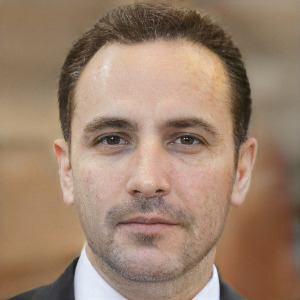 Authored by
Authored by  Reviewed by
Reviewed by 
